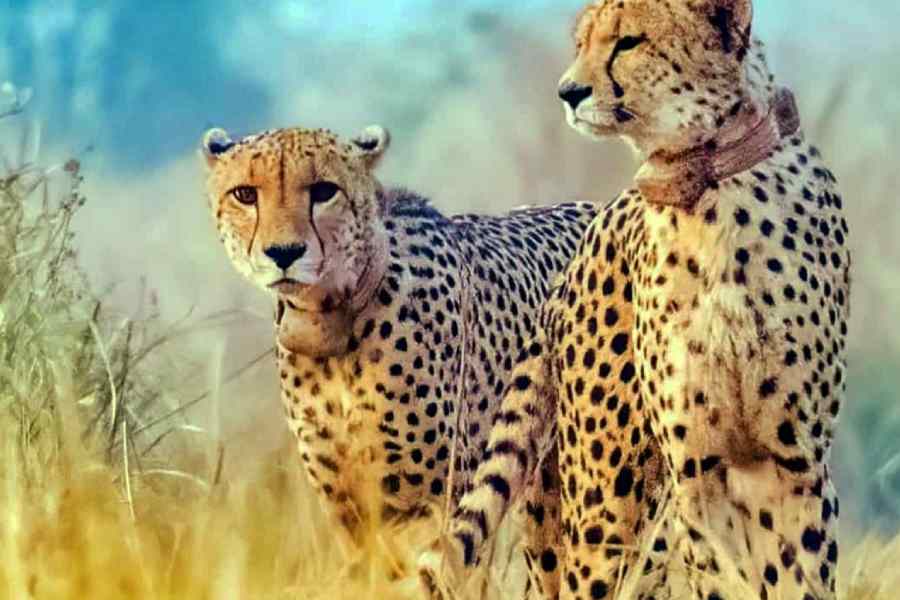Environment minister Bhupender Yadav has described the country’s project seeking to introduce African cheetahs in India as symbolising “hope for successfully restoring lost wildlife populations and ecosystems”.
The minister, in a message posted on X marking two years since the arrival of the first set of cheetahs at the Kuno National Park in Madhya Pradesh, also said: “It hasn’t been an easy road. Numerous challenges, from habitat adjustments to ensuring the cubs’ survival in the wild, were overcome.”
The minister’s message did not mention how many cheetahs were free-ranging — moving in the open wild. Repeated queries to the environment ministry sent by this newspaper asking how many cheetahs were in the open wild and how many behind fences have not evoked a response.
Four of the eight cheetahs brought from Namibia are alive, two of whom have given birth to three litters, and eight of the 12 cheetahs brought from South Africa are alive and one has given birth to six cubs.
But some Indian wildlife biologists have said there is, in reality, little to celebrate. In this interview to The Telegraph, Ravi Chellam, a big cat specialist and coordinator of the Biodiversity Collaborative, a network of conservation scientists, says the project has “not succeeded in any manner, if viewed objectively”.
Q: The environment minister this week described the cheetah project as symbolising hope for successfully restoring wild populations. How do you view progress on the cheetah project?
Chellam: The project has not succeeded, if viewed objectively. As on date, all 12 surviving adult cheetahs of the 20 flown in and 12 surviving cubs of the 17 born in India are in captivity — within fenced enclosures, ranging in size from 0.6sqkm to 1.1sqkm. None of the cubs have spent even a single day ranging free in the wild and the adults have spent most of the past 12 months in captivity. All parameters for success in the cheetah action plan were pegged on free-ranging cheetahs, not cheetahs within fenced enclosures. The plan did not envisage long-term captivity of imported African cheetahs. There is nothing to celebrate — on the contrary, there is plenty to be worried about the state of wildlife in India and the negative impacts of this ill-conceived and wasteful exercise.
Q: What specific negative impacts — could you please elaborate?
Chellam: The events of the past two years in Kuno have been a blow to the hard-earned credibility and reputation of Indian wildlife scientists and managers. This project has turned into a massive distraction from higher priority conservation initiatives, especially for highly endangered species like gharial, the great Indian bustard and caracal, and the translocation of Asiatic lions. The distraction has been from both a conservation attention perspective as well as funding.
Q: Some environment ministry officials have in the past cited the birth of cubs and their thriving in Kuno among the elements of the project’s success. Do you agree?
Chellam: The cubs are in enclosures located within Kuno. The cheetahs are being fed by releasing chital and their food is also being supplemented with buffalo meat. It would therefore be misleading to describe the cubs as thriving in the wild.
Q: The cheetahs have been in captivity for so long. Can they be released into the wild?
Chellam: At least two cheetahs haven’t ranged free even for a single day till now. Long-term captivity, defined by Namibian regulations as 90 days or longer, affects the fitness of the cheetahs, which means their ability to hunt and survive in the open wild. Under Namibian regulations, these cheetahs are unfit to be released to range free in the wild. The average home range size of cheetahs is 750sqkm while the average size of the enclosure in which they are currently being held in Kuno is less than 1sqkm. Even within these small enclosures, their diet is being supplemented with buffalo meat.
Q: What do you think is the source of hesitation or reluctance of the cheetah project managers to release more cheetahs into the open wild in Kuno?
Chellam: Unfortunately, this project has suffered from disregard for science, expertise and well-intentioned advice and criticism. Lack of sufficient communication, coordination, transparency and accountability have compounded the problems over the past two years.
This has led to shifting goalposts. It looks like the main aim of those currently managing the project is to prevent the adult cheetahs from dying, to breed the cheetahs in captivity, and to continue importing cheetahs from Africa. The project’s original objectives, which were to maintain clusters of cheetahs in the open wild, seem to have been ignored as factors other than conservation currently dominate its implementation. It is no longer a conservation project but is turning into a set of glorified safari parks with small fenced reserves focussed on captive breeding of African cheetahs.










